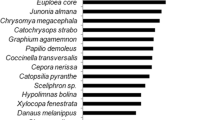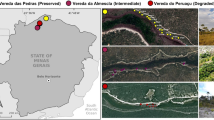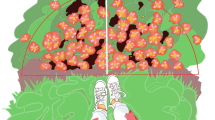Abstract
Plant-flower visitor interaction is one of the most important relationships regarding the co-existence of the floral and faunal communities. The implication of network approaches is an efficient way to understand the impact of community structure on ecosystem functionality. To understand the association pattern of flower visitors, we performed this study on Avicennia officinalis and Avicennia marina mangroves from the islands of Indian Sundarban over three consecutive years. We found that visiting time and sites (islands) influenced the abundance of visitors. The bipartite networks showed a significant generalized structure for both site-visitor and visiting time-visitor networks where the strength and specialization of visitor species showed a highly and moderately significant positive correlation between both networks respectively. All the site-wise visiting time-visitor networks and year-wise site-visitor networks were significantly modular in structure. For both the plants, most of the visitors showed a generalized association pattern among islands and also among visiting times. Additionally, the study of the foraging behavior of dominant visitors showed Apis dorsata and Apis mellifera as the potential visitors for these plants. Our results showed that flower visitor networks are spatiotemporally dynamic. The interactions of visitors with flowers at different times influence their contribution to the network for becoming a generalist or peripheral species in the context of their visiting time, which may subsequently change over islands. This approach will help to devise more precise plant species-specific conservation strategies by understanding the contribution of visitors through the spatiotemporal context.





Similar content being viewed by others
Data availability
All the data except GLMM dataset are available in Zenodo (https://doi.org/10.5281/zenodo.7612548). The data for GLMM analysis and foraging behavior will be provided on request to the first or corresponding author.
Code availability
All the codes are available in Zenodo (https://doi.org/10.5281/zenodo.7612548).
References
Akter, A., Biella, P., Batary, P., & Klecka, J. (2020). Changing pollinator communities along a disturbance gradient in the Sundarbans mangrove forest: A case study on Acanthus ilicifolius and Avicennia officinalis. Global Ecology and Conservation, 24, e01282.
Albano, S., Salvado, E., Borges, P. A. V., & Mexia, A. (2009). Floral visitors, their frequency, activity rate and index of visitation rate in the strawberry fields of Ribatejo, Portugal: Selection of potential pollinators. Part 1. Advances in Horticultural Sciences, 23, 238–245.
Alongi, D. M. (2002). Present state and future of the world’s mangrove forests. Environment Conservation, 29, 331–349.
Bakshi, M., Ghosh, S., Chakraborty, D., Hazra, S., & Chaudhuri, P. (2018). Assessment of potentially toxic metal (PTM) pollution in mangrove habitats using biochemical markers: A case study on Avicennia officinalis L. in and around Sundarban, India. Marine Pollution Bulletin, 133, 157–172.
Barzoki, Z. E., Ebrahimi, M., & Sadeghi, S. (2019). Odonata diversity and species associations in Northwest Central Plateau of Iran. Journal of Insect Conservation. https://doi.org/10.1007/s10841-019-00211-4
Bascompte, J., Jordano, P., & MeliánOlesen, C. J. J. M. (2003). The nested assembly of plant-animal mutualistic networks. Proceedings of the National Academy of Sciences of the United States of America, 100, 9383–9387. https://doi.org/10.1073/pnas.1633576100. PMID: 12881488.
Bates, D., Mächler, M., Bolker, B., & Walker, S. (2015). Fitting linear mixed-effects models using lme4. Journal of Statistical Software, 67(1), 1–48. https://doi.org/10.18637/jss.v067.i01
Bhowmik, A. K., Padmanaban, R., Cabral, P., & Romeiras, M. M. (2022). Global mangrove deforestation and its interacting social-ecological drivers: A systematic review and synthesis. Sustainability, 14, 4433. https://doi.org/10.3390/su14084433
BSI ENVIS. http://www.bsienvis.nic.in/Database/IndianMangroves_3941.aspx. Accessed 18 Feb 2022.
Chakrabarty, K. (1985). Sundarbans (India) honey and mangrove swamps. Journal of the Bombay Natural History Society, 84(1), 133–137.
Chakraborti, U., Mitra, B., & Bhadra, K. (2019). Diversity and ecological role of insect flower visitors in the pollination of mangroves from the Indian Sundarbans. Current Science, 117(6), 1060–1070.
Chakraborti, U., Mitra, B., & Bhadra, K. (2021). Island based association pattern and foraging profile of insect flower visitors on Aegialitis rotundifolia —A near threatened mangrove plant from Indian Sundarban. Neotropical Entomology. https://doi.org/10.1007/s13744-021-00911-0
Chakraborty, P., Chatterjee, S., Smith, B. M., & Basu, P. (2021). Seasonal dynamics of plant pollinator networks in agricultural landscapes: How important is connector species identity in the network? Oecologia, 196, 825–837.
Corbet, S. A. (1978). Bee visits and the nectar of Echium vulgare L. and Sinapis alba L. Ecological Entomology, 3, 25–37.
Delignette-Muller, M. L., & Dutang, C. (2015). fitdistrplus: An R package for fitting distributions. Journal of Statistical Software, 64(4), 1–34. https://doi.org/10.18637/jss.v064.i04
Dormann, C. F. (2011). How to be a specialist? Quantifying specialization in pollination networks. Network Biology, 1, 1–20.
Dormann, C. F., Gruber, B., & Fruend, J. (2008). Introducing the bipartite package: Analysing ecol network. R News, 8(2), 8–11.
Dormann, C. F., Fruend, J., Bluethgen, N., & Gruber, B. (2009). Indices, graphs and null models: Analyzing bipartite ecological networks. Open Journal Ecology, 2, 7–24.
Duke, N. C. (1991). A systematic revision of the mangrove Genus Avicennia (Avicenniaxeae) in Australasia. Australian Systematic Botany, 4, 299–324.
Dupont, Y. L., & Olesen, J. M. (2009). Ecological modules and roles of species in heathland plant-insect flower visitor networks. Journal of Animal Ecology, 78, 346–353.
Dupont, Y. L., & Olesen, J. M. (2012). Stability of modular structure in temporal cumulative plant-flower-visitor networks. Ecological Complexity, 11, 84–90.
Dupont, Y. L., Padron, B., Olesen, J. M., & Petanidou, T. (2009). Spatio-temporal variation in the structure of pollination networks. Oikos, 118, 1261–1269.
Freitas, L., & Sazima, M. (2006). Pollination biology in a tropical high-altitude grassland in Brazil: Interactions at the community level. The Annals of the Missouri Botanical Garden, 93, 465–516.
Gamito, S. (2010). Caution is needed when applying Margalef diversity index. Ecological Indicators, 10, 550–551.
Gani, M. O. (2001). The giant honeybee (Apis dorsata) and honey hunting in Sundarbans reserved forests of Bangladesh. Apimondia. In: 2001: Proceedings of the 37th International Apicultural Congress, 28 Octobere1 November (Durban).
Ghosh, A., Gupta, S., Maity, S., & Das, S. (2008). Study of floral morphology of some Indian mangroves in relation to pollination. Research Journal of Botany, 3, 9–16.
Giri, S., Mukhopadhyay, A., Hazra, S., Mukherjee, S., Roy, D., Ghosh, S., Ghosh, T., & Mitra, D. (2014). A study on abundance and distribution of mangrove species in Indian Sundarban using remote sensing technique. Journal of Coastal Conservation., 18, 359–367. https://doi.org/10.1007/s11852-014-0322-3
Gómez-Murillo, L., & Cuartas-Hernández, S. E. (2016). Patterns of diversity of flower-visitor associations to the understory Araceae in a tropical mountain forest in Colombia. Journal of Insect Conservation, 20, 1069–1085.
Gu, Z., Gu, L., Eils, R., Schlesner, M., & Brors, B. (2014). Circlize implements and enhances circular visualization in R. Bioinformatics, 30, 2811–2812.
Gupta, S., Ghosh, A., Maity, S., & Das, S. (2008). Pollen morphology and viability of some Indian mangrove. Annals of Tropical Research, 30(1), 60–71.
Hammer, Ø., Harper, D. A. T., & Ryan, P. D. (2001). PAST: Paleontological statistics software package for education and data analysis. Palaeontologia Electronica 4(1), 9. http://palaeo-electronica.org/2001_1/past/issue1_01.html
Hermansen, T. D., Britton, D. R., Ayre, D. J., & Minchinton, T. E. (2014). Identifying the real pollinators? Exotic honeybees are the dominant flower visitors and only effective pollinators of Avicennia marina in Australian Temperate mangroves. Estuaries and Coasts, 37, 621–635.
Herrera, C. M. (1989). Pollinator abundance, morphology, and flower visitation rate: Analysis of the quantity component in a plant pollinator system. Oecologia, 80, 241–248.
Hu, L., Dong, Y., & Sun, S. (2019). Relative species abundance successfully predicts Nestedness and interaction frequency of monthly pollination networks in an alpine meadow. PLoS ONE, 14(10), e0224316. https://doi.org/10.1371/0224316
Hung, K. L. J., Kingston, J. M., Albrecht, M., Holway, D. A., & Kohn, J. R. (2017). The worldwide importance of honey bees as pollinators in natural habitats. Proceedings of Royal Society B, Biological Sciences, 285, 20172140. https://doi.org/10.1098/rspb.2017.2140
Hung, K. L. J., Kingston, J. M., Lee, A., Holway, D. A., & Kohn, J.R. (2019) Non-native honey bees disproportionately dominate the most abundant floral resources in a biodiversity hotspot. Proceedings of Royal Society B, Biological Sciences, 286, 20182901.
Jonathan, J. K., & Kulkarni, P. P. (1986) Manual: Collection, preservation and identification of insects and mites of economic importance. B. K. Tikader (Eds.) Zoological Survey of India.
Jost, L. (2006). Entropy and diversity. Okios, 113, 363–375.
Kathiresan, K. (2018). Mangrove forests of India. Current Science, 114(5), 976–981.
Kathiresan, K., & Bingham, B. L. (2001). Biology of mangroves and mangrove ecosystems. Advances in Marine Biology, 40, 81–251.
Kay, K. M., & Schemske, D. W. (2003). Pollinator associations and visitation rates for 11 species of Neotropical costus (Costaceae). Biotropica, 35(2), 198–207.
Kehimkar, I. (2008). The book of Indian butterflies. Bombay natural history society.
Kishi, S., & Kakutani, T. (2020). Male visitors may decrease modularity in flower–Visitor networks. Frontiers of Ecology and Evolution, 8, 124. https://doi.org/10.3389/fevo.2020.00124
Kumar, M. V. S., Bandyopadhyay, U. K., Lalitha, N., & Saratchandra, B. (2017). Biology and feeding efficacy of Micraspis discolor, a potential biological control agent of whitefly Dialeuropora decempuncta. Journal of Entomology and Zoology Studies, 6(1), 938–941.
Kunte, K. (2000). Indian- A lifescape butterflies of peninsular India. M. Gadgil (Ed.) Indian Academy of Science, University Press.
Layek, U., Kundu, A. B., & S, Karmakar, P. (2021). Impact of managed stingless bee and western honey bee colonies on native pollinators and yeild of watermelon: A comparative study. Annals of Agricultural Sciences, 66(1), 38–45.
Lázaro, A., Müller, A., Ebmer, A. W., Dathe, H. H., Scheuchl, E., Schwarz, M., Risch, S., Pauly, A., Devalez, J., Tscheulin, T., Gómez-Martínez, C., Papas, E., Pickering, J., Waser, N. M., & Petanidou, T. (2021). Impacts of beekeeping on wild bee diversity and pollination networks in the Aegean Archipelago. Ecography, 44(9), 1353–1365. https://doi.org/10.1111/ecog.05553
Lenth, R. (2019). emmeans: Estimated marginal means, aka least-squares means. R package version 1.4.2. https://CRAN.Rproject.org/package=emmeans
Mace, G. M., Norris, K., & Fitter, A. H. (2012). Biodiversity and ecosystem services: A multilayered relationship. Trends in Ecology and Evolution, 27(1), 19–26.
Magrach, A., Gonzalez-Varo, J. P., Boiffier, M., Vila, M., & Bartomeus, I. (2017). Honeybee spillover reshuffles pollinator diets and affects plant reproductive success. Nature Ecology and Evolution, 1, 1299.
Meerabai, G. (2012). Visitation rate, effectives and efficiency of pollinators to Cadabafruiticosa (Linn.) Druce. Bioscan, 7(3), 483–485.
Mitra, B., Biswas, O., Roy, S., & Chakraborti, U. (2015). Pollinators of mangrove in the perspective of Indian Sundarbans. ENVIS Newsletter Zoological Survey of India, 21, 6–11.
Olesen, J. M., Bascompte, J., Dupont, Y. L., & Jordano, P. (2007). The modularity of pollination network. Proceedings of the National Academy of Sciences, 104(50), 19891–19896.
Olito, C., & Fox, J. W. (2014). Species traits and abundances predict metrics of plant-pollinator network structure, but not pairwise interactions. Okios. https://doi.org/10.1111/oik.01439
Piazzon, M., Larrinaga, A. R., & Samtamaria, L. (2011). Are nested networks more robust to disturbance? A test using epiphyte-tree, comensalistic networks. PLoS ONE, 6(5), e19637. https://doi.org/10.1371/journal.pone.001963
Purvis, E. E. N., Meehan, M. L., & Lindo, Z. (2019). Agricultural field margins provide food and nesting resources to bumblebees (Bombus spp., Hymenoptera: Apidae) in Southwestern Ontario, Canada. Insect Conservation and Diversity. https://doi.org/10.1111/icad.12381
Raju, A. J. S. (1990). Observation on the floral biology of certain mangroves. Proceedings of the Indian National Science Academy., B56(4), 367–374.
Raju, A. J. S. (2013). Reproductive ecology of mangrove flora: Conservation and management. Transylvanian Review of Systematical and Ecological Research, 15(2), 133–184.
Raju, A. J. S., Subba Rao, P. V., Kumar, R., & Rama Mohan, S. (2012). Pollination biology of the crypto-viviparous Avicennia species (Avicenniaceae). Journal of Threatened Taxa, 4(15), 3377–3389.
Roy, S., Chakraborty, S. K., Parui, P., Chakraborti, U., Biswas, O., & Mitra, B. (2016) Redescription of Cadrema pallid Var. Bilineata(de Meijere, 1904) (Diptera:Chloropidae) and its role as pollinator and carrion feeder from Indian Sundarbans. Ambient Science, 3(2), https://doi.org/10.21276/ambi.2016.03.2.nn01
RStudio Team. (2020). R-Studio: Integrated development environment for R. RStudio version 1.3.1056, PBC, Boston, MA URL http://www.rstudio.com/
Sanderson, C. E., Orozco, B. S., Hill, P. S. M., & Wells, H. (2006). Honeybee (Apis mellifera ligustica) response to differences in handling time, rewards and flower colours. Ethology, 112, 937–946.
Sarkar, S. K., Reeve, R., Thompson, J., Paul, N. K., & Matthiopoulos, J. (2016). Are we failing to protect threatened mangrove in the Sundarbans world heritage ecosystem? Scientific Reports. https://doi.org/10.1038/srep21234
Saunders, M. E., & Rader, R. (2019). Network modularity influences plant reproduction in a mosaic tropical agroecosystem. Proceedings of Royal Society B, 286, 20190296. https://doi.org/10.1098/rspb.2019.0296
Selvam V, Eganathan P, Karunagaran VM, Ravishankar T, Ramasubramanian R (2004) Mangrove plants of Tamil Nadu. M. S. Swaminathan Research Foundation, Chennai
Shankar, C., Mohan, M., Sampathkumar, M., Lydia, C. H., & Katti, G. (2012). Functional significance of Micraspis discolor (F.) (Coccinellidae: Coleoptera) in rice ecosystem. Journal Applied Entomology, 137(8), 601–609. https://doi.org/10.1111/jen.12035
Sreelekshmi, S., Nandan, S. B., Kaimal, S. V., & Radhakrishnan, C. K. (2020). Mangrove species diversity, strand structure and zonation pattern in relation to environmental factors-A case study at Sundarban delta, east coast of India. Regional Studies in Marine Science. https://doi.org/10.1016/j.rsma.2020.101111
Subba Reddi, C., Raju, A. J. S., & Narayana Reddy, S. (1995). Pollination ecology of Avicennia officinalis (Avicennaceae). Journal of Palynology, 31, 253–260.
Thatoi, H., Samantaray, D., & Das, S. K. (2016). The genus Avicennia, a pioneer group of dominant mangrove plant species with potential medicinal values: A review. Frontiers in Life Science, 9(4), 267–291. https://doi.org/10.1080/21553769.2016.1235619
Thompson, J. D. (2001). How do visitation patterns vary among pollinators in relation to floral display and floral design in a generalist pollination system? Oecologia, 126, 386–394.
Thomson, J. D., & Plowright, R. C. (1980). Pollen carryover, nectar rewards, and pollinator behaviour with special reference to Diervilla lonicera. Oecologia (Berl.), 46, 68–74.
Vinaya, K., & Binoy, C. F. (2022). Foraging activity and breeding system of Avicennia officinalis (Avicenniaceae) in Kerala, India. Journal of Threatened Taxa, 14(11), 22098–22104.
Acknowledgements
PRG, University of Kalyani and DST-PURSE 2023-24 should be acknowledged for partial financial support, and the authors are also grateful to the people of Sundarban Biosphere Reserve for their support and cooperation.
Funding
The corresponding author, KB, is grateful for financial support to the Department of Science & Technology-Uzbek (INT/UZBEK/P-09), 2021–2024.
Author information
Authors and Affiliations
Contributions
UC did the field study, designed the research, and analyzed the data. BM designed the research and guided the field study, and KB analyzed, compiled and reviewed the data, and wrote the manuscript.
Corresponding author
Ethics declarations
Conflict of interest
The authors declare no competing interests.
Additional information
Publisher's Note
Springer Nature remains neutral with regard to jurisdictional claims in published maps and institutional affiliations.
Supplementary Information
Below is the link to the electronic supplementary material.
Rights and permissions
Springer Nature or its licensor (e.g. a society or other partner) holds exclusive rights to this article under a publishing agreement with the author(s) or other rightsholder(s); author self-archiving of the accepted manuscript version of this article is solely governed by the terms of such publishing agreement and applicable law.
About this article
Cite this article
Chakraborti, U., Mitra, B. & Bhadra, K. Exploring spatiotemporal dynamics of flower visitor association pattern on two Avicennia mangroves: a network approach. Environ Monit Assess 195, 1244 (2023). https://doi.org/10.1007/s10661-023-11845-y
Received:
Accepted:
Published:
DOI: https://doi.org/10.1007/s10661-023-11845-y




